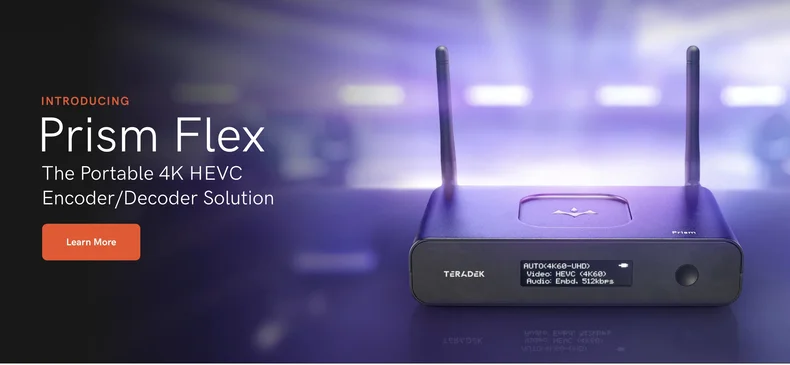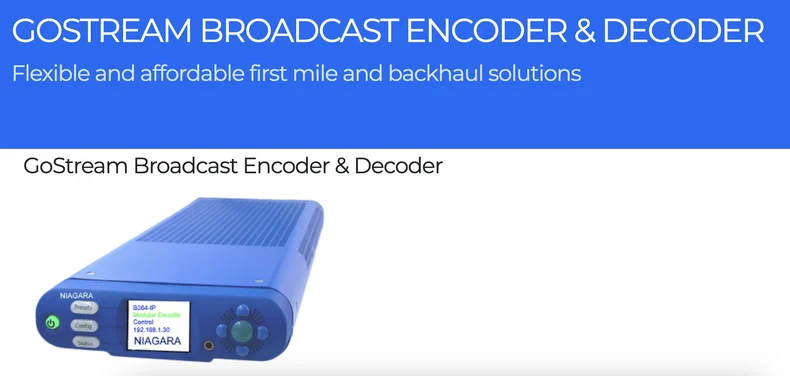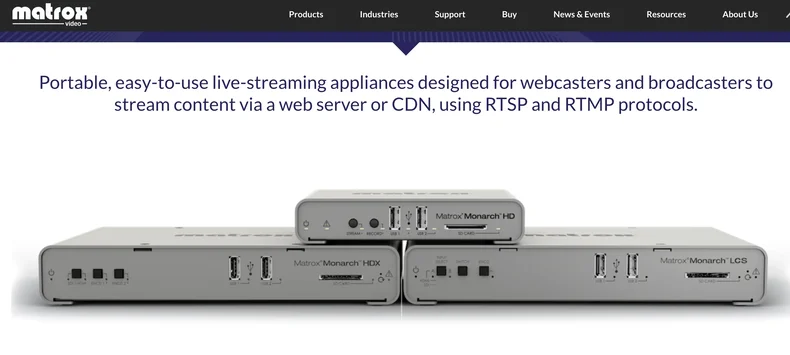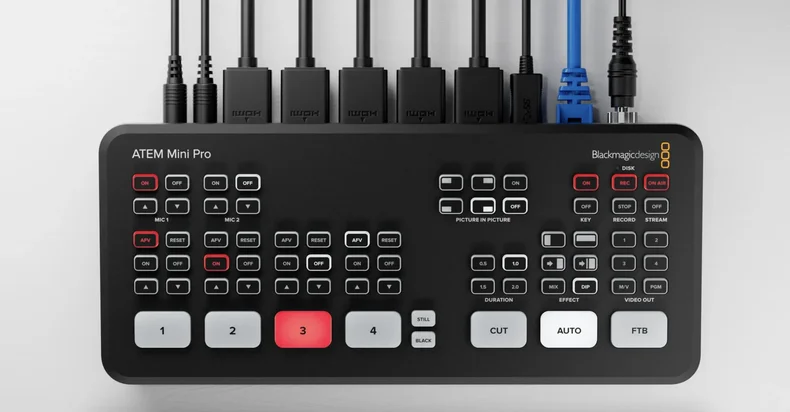In a world where over 2500 videos are published every minute, live streaming has emerged as one of the most powerful mediums to reach and engage with a wider audience. Whether you’re a content creator, event organizer, or a marketing professional, live streaming allows you to share your message in real-time, fostering a more personal connection with your viewers.
However, to ensure a seamless and high-quality viewing experience, free from lag or buffering, it’s crucial to equip yourself with the right tools.
At the heart of a successful live stream is a robust live streaming encoder.
This essential piece of hardware converts raw video files into a format suitable for live streaming, ensuring your content is delivered smoothly and efficiently. But with the myriad of options available in the market, how do you choose the best one?
Well, that’s what we will help you decide in this article. We’ll delve into the world of live streaming encoders, helping you understand their role and importance. Moreover, we’ll explore seven of the best hardware encoder solutions currently available, equipping you with the knowledge to make an informed decision.
Let’s begin!
What is a live streaming encoder?
A live streaming encoder is a device or application that converts, or encodes, your video and audio content into a digital format, enabling it to be transmitted over the internet.
The process of encoding involves compressing the video and audio content, making it suitable for streaming across various internet speeds. This compression is crucial because it reduces the size of the video and audio data without compromising the quality, ensuring viewers can watch your content smoothly, without buffering or lag.
Encoders come in two forms: software and hardware.
- Software encoders are programs that run on your computer.
- Hardware encoders are standalone devices dedicated to encoding and streaming.
Both have their pros and cons, and the choice between the two depends on factors such as your budget, portability needs, and the complexity of your live stream.
Let’s understand how encoders work with an example. Imagine you’re hosting a live webinar. Your camera captures the video, and your microphone captures the audio through analog signals. A live streaming encoder takes these signals and transforms them into a digital format that can be streamed over the internet. Without an encoder, your live stream wouldn’t be possible.
Encoders are the linchpin in the process of live streaming. They’re the bridge that connects your content with your audience, regardless of where they are in the world.
This is why, whether you’re a content creator, event organizer, marketer, or broadcaster, understanding and choosing the right encoder is a crucial step in delivering high-quality live streams.
Encoding vs. transcoding vs. codecs
In the world of live streaming, you’ll often hear the terms encoding, transcoding, and codecs. While they may seem interchangeable, they serve different, yet interconnected, roles in the streaming process.
Encoding
As we’ve already discussed, encoding is the process of converting video and audio content into a digital format for streaming. It’s the first step in preparing your content for live streaming. Through encoding, large video and audio files are compressed into a smaller, more manageable size that can be easily transmitted over the internet without sacrificing quality.
Transcoding
Transcoding is a more specific process that occurs after encoding. It involves converting the already encoded video into various formats and sizes. Why is this necessary?
Well, not everyone watching your live stream will have the same internet speed. Some viewers may have high-speed connections, while others may be dealing with slower speeds.
Transcoding allows these different users to watch the video at the best size for their internet speed, minimizing buffering and ensuring a better viewing experience. It creates multiple versions of the same video at different bitrates and resolutions, known as renditions.
Viewers can then automatically switch between these renditions depending on their network conditions, a process known as adaptive bitrate streaming.
Codecs
Codec stands for coder-decoder. A codec is a tool that encodes video content for storage or transmission and then decodes it for viewing or editing. It’s like the engine behind the encoding and transcoding processes.
There are many different types of codecs, each with its unique algorithms and capabilities. Some are designed to prioritize quality, while others focus on reducing file size. The choice of codec can significantly impact the quality of your live stream and the amount of bandwidth it requires.
Hardware vs. software encoders: Which is better?
When it comes to live streaming, one of the key decisions you’ll need to make is whether to use a hardware or software encoder. Both have their merits and drawbacks, and the right choice largely depends on your specific needs, budget, and technical expertise.
Let’s weigh their pros and cons.
Hardware encoders
Hardware encoders are dedicated devices designed specifically for encoding. They’re built to handle the demands of converting video and audio signals into a digital format, making them highly reliable and efficient.
| Pros | Cons |
| Reliability: Hardware encoders are typically more stable than their software counterparts. They’re less prone to crashes and can handle continuous streaming for long periods. Speed: These devices are faster at encoding since they’re designed solely for this purpose. No CPU demand: As standalone devices, hardware encoders don’t put any strain on your computer’s CPU, freeing up resources for other tasks. | Cost: Hardware encoders are often more expensive than software encoders, making them a significant investment. Less flexibility: These encoders are less customizable than software encoders. While they excel at their primary function, they offer fewer options to tweak settings or add new features. |
Software encoders
Software encoders are programs installed on your computer. They’re generally more flexible and customizable than hardware encoders, but they also demand more of your computer’s resources.
| Pros | Cons |
| Cost-effective: Software encoders are typically cheaper than hardware encoders. Some even offer free versions, making them a great choice for beginners or those on a tight budget. Flexibility: These encoders offer a wealth of customization options. You can easily adjust settings, upgrade features, or integrate with other software. Ease of setup: Software encoders are usually easier to set up than hardware encoders, with more intuitive interfaces and user-friendly controls. | Reliability: They can be less reliable than hardware encoders. They’re more prone to crashes, especially if your computer is running multiple programs simultaneously. CPU demand: Software encoders can put a significant strain on your computer’s resources, potentially slowing down other operations. Speed: These encoders can be slower at encoding, especially compared to dedicated hardware encoders. |
Choosing between a hardware and software encoder isn’t a matter of one being categorically better than the other. It’s about finding the right fit for your specific needs.
Beginners or those with simpler streaming requirements might find software encoders more than sufficient, given their lower cost and ease of use. On the other hand, professionals with more advanced streaming needs may lean towards the reliability and efficiency of hardware encoders.
Ultimately, the best choice is the one that helps you deliver a high-quality streaming experience to your audience.
How do you choose the best hardware encoder?
Selecting the best hardware encoder for your live streaming needs involves several considerations. More than finding the most expensive or the most feature-rich device, you need to focus on finding the encoder that best fits your specific requirements and circumstances.
Here are some key factors to consider:
Budget
The first thing to consider is your budget. While hardware encoders are generally more expensive than software encoders, there’s a wide range of prices within the hardware category itself.
Some encoders are relatively affordable, while others can be quite pricey. It’s essential to find a balance between cost and quality, ensuring you get a reliable encoder that suits your budget.
Compatibility
Your encoder needs to work seamlessly with your chosen streaming platform. Most hardware encoders will be compatible with major platforms like YouTube Live, Facebook Live, and Twitch, but if you plan to use a more niche platform, compatibility becomes even more critical.
For those planning to stream on their own website, it’s worth noting that WpStream offers compatibility with the most popular encoding solutions. This compatibility ensures a smooth integration between your encoder and the streaming service, providing a hassle-free streaming experience.
Extra features
While hardware encoders are typically more streamlined in their functionality compared to software encoders, they do offer some extra features. These might include multi-channel encoding, redundancy options, or advanced audio features.
When considering these extra features, think about your specific streaming needs.
- Do you need to stream to multiple platforms simultaneously?
- Do you require advanced audio processing?
The answers to these questions can help guide your decision.
The top 7 hardware encoders for live streaming
Choosing the right hardware encoder can make the difference between a smooth, high-quality live stream and a buffering nightmare. To help you make an informed decision, here’s a detailed comparison of the seven best hardware encoders, considering factors such as price, compatibility, and additional features.
1. Teradek
Teradek has made a solid name for itself in the live streaming industry with an impressive line of high-performance hardware encoders. Among their offerings, one model that’s particularly noteworthy is the Teradek Prism Flex.

The Teradek Prism Flex is a great addition to the Teradek family of hardware encoders, offering a wide range of features that cater to both novice and seasoned streamers. It stands out with its flexibility and robust performance, making it a valuable tool for live streaming.
The Prism Flex offers exceptional video quality with support for 4K and HD live streaming, ensuring your audience enjoys a crystal-clear viewing experience. With support for various protocols, including SRT, RTMP, and MPEG-TS, it provides you the flexibility to stream on a platform of your choice.
One significant advantage of the Prism Flex is its modular design, enabling you to add or remove input modules as needed. This feature makes the Prism Flex a versatile and scalable solution that can grow with your streaming needs.
Despite these advanced features, the Prism Flex maintains an intuitive, user-friendly interface, making it accessible even for those new to live streaming.
In terms of pricing, the Teradek Prism Flex falls in the premium range, often priced over $3,000. Of course, prices can vary based on the retailer and the specific model, so it’s recommended to check with official Teradek retailers for the most accurate pricing.
2. TriCaster
TriCaster is another heavyweight contender in the live streaming industry, known for its range of professional-grade hardware encoders. Among their innovative solutions, the TriCaster Mini has earned a reputation for its power-packed performance and versatility.

The TriCaster Mini is a remarkable all-in-one solution that redefines the concept of portable live production. With the ability to handle encoding, switching, and recording within the same compact device, it offers a streamlined workflow for live broadcasters.
Supporting up to eight video inputs, the Mini provides ample room for mixing and matching sources. It supports both HDMI and SDI connections, making it adaptable to a variety of broadcasting setups.
The TriCaster Mini impresses with a host of advanced features designed to enhance your live streaming experience. It comes with multi-channel Skype integration, an especially valuable feature for broadcasters who often host remote guests. Adding to its versatility, it also offers virtual sets. This feature allows you to replace the actual background with a digital one, making your broadcast look as though it’s taking place in a professional studio.
3. Niagara Video
Niagara Video is a brand known for its extensive lineup of encoders designed to cater to various broadcasting needs. A notable model from their portfolio is the Niagara GoStream B264. This portable, battery-powered encoder is specifically designed for broadcasters on the move.

The GoStream B264 boasts a compact design that’s built for mobility. With its own built-in battery, it offers the convenience of untethered operation, making it perfect for on-location live streams or remote broadcasts.
Compatibility is another strength of the GoStream B264. It supports a multitude of streaming protocols and platforms, providing users with flexibility and adaptability. Whether you’re streaming to Facebook Live, YouTube, or any other popular platform, the GoStream B264 has got you covered.
While the GoStream B264 may lack some of the advanced features found in premium models, it excels in areas that matter most for on-the-go broadcasting. Its user-friendly interface, combined with its portability and versatility, make it a great choice for users who frequently find themselves streaming from various locations.
4. Matrox
Matrox is a trusted name in the video technology industry, recognized for its reliable and efficient hardware encoders. Among their offerings, the Monarch HDX distinguishes itself with its dual-channel encoding capabilities.

The Monarch HDX is a versatile piece of equipment that allows you to stream to two different locations simultaneously. This unique dual-channel feature can be a game-changer for those looking to maximize their reach and target multiple platforms at the same time.
When it comes to compatibility, the Monarch HDX doesn’t disappoint. It supports a broad range of streaming platforms that enable users to broadcast their content to their platform of choice. Its robust performance ensures smooth and high-quality streams, irrespective of the platform you choose.
Though the Monarch HDX comes with a substantial price tag, its unique features and dependable performance make it a worthwhile investment. Its dual-channel encoding feature, in particular, sets it apart from many other encoders on the market and can be a valuable asset for multi-platform streaming.
5. Blackmagic Design ATEM Mini Pro
From the house of Blackmagic Design, a brand synonymous with high-quality video technology, comes the ATEM Mini Pro. This compact hardware encoder packs a punch, offering a range of features that you’d typically expect from larger, pricier models.

The ATEM Mini Pro shines with its multi-camera switching capability. This feature allows users to switch between multiple camera angles in real time during a live broadcast, adding a professional touch to streams. It also includes advanced audio controls, offering a higher degree of customization and fine-tuning for your broadcasts.
As far as compatibility is concerned, the ATEM Mini Pro supports direct streaming to popular platforms such as YouTube Live, Facebook Live, and Twitch. This makes it a versatile choice for a wide range of users, from content creators and influencers to small businesses looking to reach their audience through live streaming.
What sets the ATEM Mini Pro apart is its blend of affordability, compactness, and feature richness. It delivers high-end functionality in a compact, user-friendly package, making it an excellent choice for those seeking professional-grade streaming without breaking the bank.
6. URayCoder
URayCoder is a brand known for its affordable yet competent hardware encoders. One of their standout offerings is the H.264 HDMI Video Encoder, a compact, budget-friendly device that delivers reliable performance without emptying your wallet.

The H.264 HDMI Video Encoder is a compact device that doesn’t compromise on functionality. It supports a variety of streaming protocols, offering the flexibility to stream to multiple platforms based on your specific needs.
While the URayCoder’s H.264 HDMI Video Encoder may not include some of the advanced features found in high-end models, it shines in its ability to deliver consistent and reliable performance. This makes it an excellent value for money, particularly for beginners or those working with a tight budget.
7. LiveU Solo
LiveU Solo is a portable hardware encoder designed for consistent, high-quality streaming from virtually anywhere. Known for its robust performance and advanced features, the LiveU Solo caters primarily to professional broadcasters and content creators.

What sets the LiveU Solo apart is its bonded streaming capability. By combining multiple internet connections, it ensures stable and uninterrupted streaming even in challenging network conditions. This feature is a boon for those broadcasting from locations with unreliable internet, ensuring your audience enjoys a seamless viewing experience.
Being portable, the LiveU Solo is designed for on-the-go streaming. Whether you’re covering live events, conducting interviews, or streaming content in real-time from various locations, the LiveU Solo is designed to handle it all.
While the LiveU Solo comes with a higher price tag than some other encoders, its rich feature set, portability, and superior performance make it a worthwhile investment for professional broadcasters and content creators.
Here’s a brief comparison table for an overview of the encoder solutions:
| Encoder | Best features | Pros | Cons | Approximate price |
| Teradek Prism Flex | Modular design, portable, supports multiple platforms and 4K and HD live streaming, user-friendly interface. | High performance, supports various platforms, robust feature set. | Pricier than some options. | Above $3000. |
| TriCaster Mini | Versatile all-in-one solution, supports up to eight video inputs, advanced features like virtual sets and multi-channel Skype integration. | Comprehensive feature set, professional-grade performance. | Substantial investment. | Above $5,000. |
| Niagara GoStream B264 | Portable, battery-powered, supports a variety of streaming protocols. | Portability, ease-of-use, versatile. | Lacks some advanced features. | Around $1,000. |
| Matrox Monarch HDX | Dual-channel encoding, wide range of platform compatibility. | Dual-channel feature, robust performance, wide platform compatibility. | Higher price point. | Above $1,000. |
| Blackmagic Design ATEM Mini Pro | Compact, multi-camera switching, advanced audio controls, direct streaming support. | Affordability, compact size, feature-rich, multi-camera support. | Lacks some advanced features. | Around $500. |
| URayCoder H.264 HDMI Video Encoder | Affordable, supports a variety of streaming protocols, compact. | Affordable, compact, reliable, supports various protocols. | Lacks some advanced features. | Under $300. |
| LiveU Solo | Portable, bonded streaming, robust performance. | Stable, high-quality streams, portability, advanced features. | Higher price point. | Above $1,000. |
Note that prices may vary based on retailer and location, and the above pricing is provided as a rough guide only. Always check with the official retailers for the most accurate and up-to-date pricing.
Enhance your live streaming experience with WpStream
Selecting the best hardware encoder for your live streaming setup is a decision influenced by multiple factors, including your budget, the functionality you need, and the compatibility of the encoder with your chosen streaming platform.
There’s no one-size-fits-all solution. Each encoder we’ve discussed has its unique strengths and potential drawbacks, and the best one for you will align with your specific needs and objectives.
However, choosing an encoder is just one piece of the puzzle. You’ll also need to decide on a streaming platform that complements your hardware and meets your streaming requirements. This is a crucial step in ensuring your audience can view your content smoothly and reliably.
If you’re considering streaming on your own website, WpStream presents an excellent solution. Designed for streamers of all types, WpStream provides a robust, user-friendly platform that supports various encoders and delivers a seamless streaming experience.
So, are you ready to elevate your live streaming setup? Learn more about what WpStream has to offer!
Visit our features page to explore how WpStream can help you create a compelling and engaging live streaming experience for your audience.
Remember, the goal is to offer a seamless, high-quality viewing experience for your audience. Your choice of hardware encoder and streaming platform can significantly influence this, so choose wisely. Happy streaming!
Table of Content








